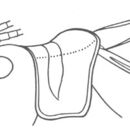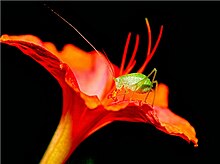en
names in breadcrumbs


Size large, form robust, the sexes subequal. Tegmina dark green; body, head, pronotum and legs paler green tinged with yellow, often becoming dull greenish-yellow in drying; tympanum of male brown. Disk of pronotum saddle-shaped, coarsely and densely punctate; metazona broader than prozona, usually distinctly sloping from the broadly rounded or subangulate hind margin to the principal transverse sulcus, the latter descending on lateral lobes much farther than the anterior sulcus; prozona about as long as metazona, crossed at middle by the deep anterior sulcus, its front margin truncate; lateral lobes subquadrate. all their margins nearly straight, the lower angles rounded. Tegmina as described under subfamily heading, those of female about two and one-half times as long as broad. Male with lower branches of cerci about one-fourth shorter than upper ones, their tips strongly incurved and partly clasping the sides of the elongate subgenital plate, the upper forks crossing each other, each ending in a minute sharp black spine. Ovipositor as described under subfamily heading. Length of body, ♂, 25—30,♀, 26—34; of pronotum,♂and♀, 5.5—6; of tegmina,♂, 32—38,♀, 34—37; of hind femora,♂, 18—21,♀, 19—23; of subgenital spine,♂, 12—14.5; of ovipositor, 16.5—20 mm. Width of pronotum,♂and♀, 6—6.5; of tegmina,♂, 17—20,♀, 14—16; of ovipositor, 3.2 mm.
This broad-winged katydid occurs in considerable numbers throughout Indiana, but is much more commonly heard than seen, as it dwells in small colonies in the densest foliage which it can find, such as the tops of shade and forest trees, the entwining vines of the grape arbor, the shrubbery of yards and orchards and the trees along fence rows. Its note is the loudest made by any member of the family, the male having the musical organ larger and better developed than in any other. The call is almost always begun soon after dusk with a single note uttered at intervals of about five seconds for a half dozen or more times. This preliminary note gives the listener the impression that the musician is tuning his instrument, preparatory to the well-known double call which is soon begun and kept up almost continuously from dark till dawn. Occasionally, in warm cloudy weather, this call is made by day, and if the musician is located he will sometimes be found resting on the topmost leaf of a shrub, swinging to and fro as the breezes blow, and sounding his cymbals in seeming unison with the movement.
This katydid reaches maturity in southern Indiana by mid-July. The song has been heard in Crawford County as early as July 10, and as late as Oct. 27, and a single female was captured in LaPorte County, near Lake Michigan, on October 15.
According to Riley (1874, 167) the eggs of the true katydid are thrust, by means of the sharp ovipositor, into crevices and soft substances, and probably, in a state of nature, into the crevices of loose bark, or in to the soft stems of woody plants. They are of a dark slate color, about 6.5x2 mm. in size, very flat, pointed at each end, and with the edges beveled off or emarginate. Caudell (1906, 33) mentions a female that was found on Plummer's Island, Md., with the ovipositor inserted into the bark of a small elm tree a few feet above the ground. Later (1918, 112) he records one as ovipositing in the bark of the black walnut.
The known range of this true katydid extends from New England and London, Ont., west to Michigan and northern Illinois, and south and west to North Carolina, northern Georgia and central Kansas. In New England it has been definitely recorded only from Massachusetts and Connecticut, Scudder (1900a, 103) stating that it is found in isolated colonies in the former State and more generally but still locally in Connecticut. Davis (1889) mentions it as occurring on Staten Island, N. Y., in late July and August. Walker (1904a, 330) states that it is common at Niagara, and that he had often heard it at Yonkers, N. Y. Caulfield (1888) records the only Ontario specimen as taken at electric light in London. It is not mentioned in any of the local Michigan lists at hand, though stated by Pettit and McDaniel to have been recorded from the State. Lugger, though giving a description and an account of its habits (1898, 226), does not record it from Minnesota but says: "If found in this State it will very likely occur in small colonies." Ball (1897) mentions it as rare at Ames, Iowa, while Bruner (1893a, 29) records it as not rare in the eastern or wooded part of Nebraska. The records south and southwest of New England are more numerous, a number of them, as far as northern Georgia, being given by R. & H. (1916, 257). Caudell (1906, 38) states that it is found in Kansas.
The Common True Katydid or Northern True Katydid (Pterophylla camellifolia) is found in the eastern United States from Massachusetts south to northern Florida and west to the start of the Great Plains, but is absent from southern Florida and most of the northern tier of states. These katydids are often heard, but rarely seen, since they generally stay in the crowns of deciduous and coniferous trees. The broad tegmina bulge noticeably on the sides, completely enclosing the abdomen and the inner wings.
The loud call of this large North American katydid (33 to 50 mm long) gave rise to the name "katydid", which is used in the U.S. and Canada for most members of the family Tettigoniidae (in Europe, these insects are known as "bush-crickets"). In the northeastern and midwestern states, the calls typically have 2 or 3 syllables. More syllables may be present in the faster calls typical in the southeastern part of the range; in the southwestern part of the range (e.g., eastern Texas and Louisiana), the pulse rate is slow and the number of pulses drops to two or one.
In a Common True Katydid chorus, large numbers of singers may synchronize their calls, filling the woods with a resounding ocean of sound. When many males are present at a location, each male synchronizes with one or the other of two groups, with the two groups alternating their songs (Elliott and Hershberger 2007). Although Common True Katydids normally sing only at night, as the weather cools late in the season, scattered singers may be heard calling slowly during the day. Female Common True Katydids lay eggs in bark crevices or soft plant tissue. The eggs hatch in the spring and the nymphs feed on foliage until they reach adulthood. Adults are first heard calling in June in Florida and in July farther north; singing ends in October.
Although they do not fly, Common True Katydids can use their wings to flutter to the ground, after which they move to a nearby tree trunk and ascend.
This is the most northern representative of a mainly tropical genus (the several other species in the tettigoniid subfamily Pseudophyllinae in the U.S. have much narrower distributions; the Florida True Katydid, Lea floridensis, is limited to peninsular Florida).
(Capinera et al. 2004; Elliott and Hershberger 2007; Himmelman 2009)
Of the call of this species Scudder (1875e) has written:
"The note, which sounds like xr, has a shocking lack of melody; the poets who have sung its praise must have heard it at the distance that lends enchantment. In close proximity the sound is excessively rasping and grating, louder and hoarser than I have heard from any other of the Locustarians in America or in Europe, and the Locustarians are the noisest of all Orthoptera. Since these creatures are abundant wherever they occur, the noise produced by them, on an evening specially favorable to their song, is most discordant. Usually the notes are two in number, rapidly repeated at short intervals. Perhaps nine out of ten will ordinarily give this number, but occasionally a stubborn insect persists in sounding the triple note—('Katy-she-did'); and as katydids appear desirous of defiantly answering their neighbors in the same measure, the proximity of a treble-voiced songster demoralizes a whole neighborhood, and a curious medley results; notes from some individuals may then be heard all the while, scarcely a moment's time intervening between their stridulations, some nearer, others at a greater distance; so that the air is filled by these noisy troubadours with an indescribably confused and grating clatter."
Caudell (1906, 32) says: "The female of this katydid is unique among Orthopterous insects, so far as known, in that they stridulate in a manner similar to that of the males. The tegmina are partially opened and closed just as are those of the males during stridulation. The roughened surface of the triangular anal areas rub over each other, like the tympani of the males, the right tegmen sliding beneath the left one. The resulting sound is a sharp, scraping note, heard easily for several yards. This sound is made by the female when disturbed by handling, but whether or not it is ever made voluntarily in nature is not known, but it presumably is when the insect is disturbed by any cause."
Identification: Length 39-50 mm. A leaf-green, deliberate-moving katydid--as befits a near-flightless species living in treetops. Length of pronotum approximately equal to its rear width; side of pronotum deeper than wide.
Habitat: Crowns of deciduous trees in forests, woodlots, and yards.
Pterophylla camellifolia, the common true katydid, is a common North American insect in the family Tettigoniidae (katydids). Within the Tettigoniidae, it belongs to the subfamily Pseudophyllinae (true katydids). Other common names include northern true katydid and rough-winged katydid.[1][2][3]
The loud, rasping, three-pulsed song, rendered "ka-ty-did", of the male of the nominate northern subspecies is the source of the vernacular name "katydid” as applied to any tettigoniid.[4] It is a nearly flightless species that, in contrast with other katydids, often walks, runs, or hops rather than leaping or flying.[5] It lives in the canopy of deciduous trees, where it feeds on the foliage.[4][5] It can reach up to 50 mm (2 in) in length.[4]
The singing rate is temperature dependent.[6][7] Four populations of this species can be distinguished by song characteristics:[4]
Song at 20°C, Illinois
This species' original scientific name was Locusta camellifolia. The genus Pterophylla was created for it by Kirby in 1825. Three subspecies are recognized for P. camellifolia:[3]
 Common true katydid nymph on a Mirabilis jalapa flower
Common true katydid nymph on a Mirabilis jalapa flower Pterophylla camellifolia, the common true katydid, is a common North American insect in the family Tettigoniidae (katydids). Within the Tettigoniidae, it belongs to the subfamily Pseudophyllinae (true katydids). Other common names include northern true katydid and rough-winged katydid.
The loud, rasping, three-pulsed song, rendered "ka-ty-did", of the male of the nominate northern subspecies is the source of the vernacular name "katydid” as applied to any tettigoniid. It is a nearly flightless species that, in contrast with other katydids, often walks, runs, or hops rather than leaping or flying. It lives in the canopy of deciduous trees, where it feeds on the foliage. It can reach up to 50 mm (2 in) in length.